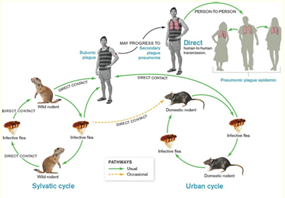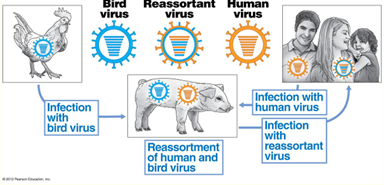pathogens shaping history
1/6
There's no tags or description
Looks like no tags are added yet.
Name | Mastery | Learn | Test | Matching | Spaced |
|---|
No study sessions yet.
7 Terms
yersinia pestis
gram-negative bacteria
caused the bubonic (caused buboes, swollen lymph nodes ~50% mortality rate) and pneumonic plague
when sepsis goes into the blood and travels to the lungs, you get the pneumonic plague: 90-100% mortality rate
treatable in less than 24 hrs since first symptoms
F1 toxin makes fleas less hungry
transmission through rodents, prairie dogs, rodent fleas and human respiratory aerosol (pneumonic)
treatable via antibiotics and vaccine (but limited value)
yersinia pestis is a zoonotic pathogen affectin rodents and wild dogs
when the rodent is infected, the fleas will be infected as well and because they are super hungry, they will turn to humans for their food source instead, as the rodents would be dead

epizootics
animal equivalent of an epidemic
phytophthora infestans
causes potato blight/ late blight
symptoms:white mycelium growth over surface of leaves and tubers (potatoes)
classification: spore-forming, oomycete (water mold)
virulence: approaching 100% of crops
transmission/reservoir: very stable spore structures
treatment: fungicides and copper sulfate (can cause issues with heavy metal toxicity)
how did potato blight occur?
potatoes originated from Peru, which were brought over by spanish and british sailors in the late 1500s, but they only brought back a few species
pathogens share similar geographic distribution with their hosts and usually co-evolve with them
the blight was not a problem in Peru as there was a large variety however, if the monoculture is susceptible to blight, then the potatoes will be infected, and the soil will be full of spores
influenza virus
causes influenza
symptoms: fever, chills, cough, chest pain, soar throat, muscle pain
virulence: 0.01-50% depending on the strain
major virulence facots: changes in the H and N proteins can be linked to virulence
classification: negative ssRNA
reservoir/transmission: human reservoir/ respiratory droplets and can also infect other animals
treatments: antiviral drugs and vaccines (varied efficacy)
how does genetic diversity in influenza form?
re-assortment of genetic material generates new influenza particles
influenza has 8 vital chromosomes
